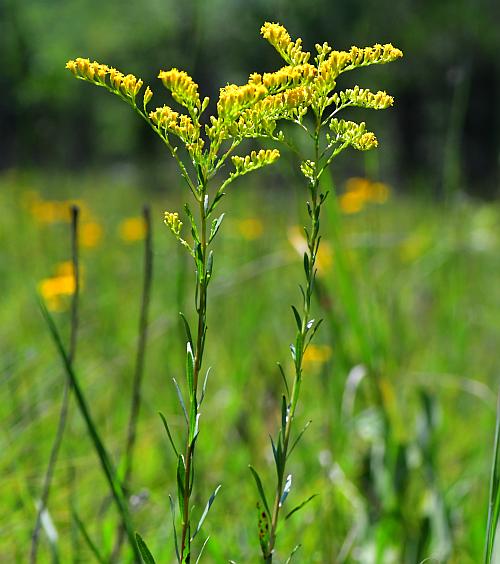Solidago gattingeri Chapm. ex A. Gray
Gattinger's Goldenrod

Native
CC = 10
CW = 5
MOC = 26
© SRTurner
Solidago gattingeri Chapm. ex A. GrayGattinger's Goldenrod | |
 |
Native CC = 10 CW = 5 MOC = 26 |
© SRTurner |
|
Family - Asteraceae/Astereae Habit - Perennial forb with a relatively short, stout, branched rootstock, not producing rhizomes. Stem - Ascending to erect, to 80 cm, single or multiple, finely longitudinally lined, glabrous below the inflorescence (the inflorescence branches sometimes sparsely, pubescent), not shiny, not glaucous, the nodes usually lacking axillary leaf clusters.
Leaves - Alternate, simple, the largest toward the base of the plant. Offsets sometimes present. Basal and lowermost stem leaves with the blade 8-17 cm long, 1-2 cm wide, mostly 7-10 times as long as wide, narrowly oblanceolate to oblanceolate, somewhat thickened and stiff, tapered gradually to the winged petiole at the base, angled to a sharply pointed tip, the margins entire or finely and sharply toothed, minutely hairy, the surfaces glabrous, the undersurface with 3 main veins, the lateral pair much finer than the midvein, the veinlets usually easily observed, forming an irregular, dense network. Median and upper stem leaves progressively smaller, 1-6 cm long, narrowly oblanceolate to narrowly elliptic or nearly linear, sessile or short-petiolate, often with only 1 main vein, otherwise similar to the lower stem leaves.
Inflorescences - Pyramidal, relatively dense, usually broad panicles, the longer branches and often also the tip arched or nodding, the heads oriented upward along the branches.
Heads - Involucre 3-5 mm long, the bracts in 3 or 4 unequal series. Involucral bracts oblong-ovate to narrowly lanceolate and rounded or bluntly pointed (those of the outer series often sharply pointed) at the appressed-ascending tip, the margin sparsely hairy toward the tip, the outer surface glabrous, usually entirely yellowish, the midvein somewhat thickened and keeled, with no additional veins visible. Receptacle naked.
Florets - Ray florets 5-8, pistillate, the corollas 2-3 mm long, yellow. Disc florets 3-9, perfect, the corollas 3-4 mm long, the lobes 0.5-0.8 mm long, yellow. Pappus 2-3 mm long, some of the bristles slightly thickened toward the tip.
Fruits - Achenes 1.5-2.0 mm long, obovoid, glabrous or less commonly sparsely hairy. Flowering - July - October. Habitat - Calcareous glades and rock outcrops in upland prairies. Origin - Native to the U.S. Lookalikes - Broadly, several other species of Solidago such as S. nemoralis, S. juncea, S. missouriensis, and others. Other info. - This smallish goldenrod is found on glades, where it blooms late in the year. Its distribution in Missouri is peculiar, with three main groupings: along the southern border, a cluster centered on Jefferson County in the east-central part of the state, and a cluster centered on Hickory County toward the eastern part of the state. These populations comprise the great majority of the plant's distribution, with uncommon populations occurring in only two other states (Arkansas and Tennessee). It is about as close as Missouri comes to having an endemic plant species. The highly restricted distribution makes this plant uncommon overall, though it can be abundant in the proper habitats. The plant is recognized by its basally disposed leaves which become quite small upward on the plant, and pyramidal panicles of small yellow flower heads. It is one of the smaller of the goldenrods. Photographs taken at Victoria Glade, Jefferson County, MO, 9-19-2011 and 8-19-2020 (SRTurner). |